This is a companion piece to The 16 Rules of Brand Strategy.

Identity precedes everything in brand strategy.
Before your company, before your product, before your market, there is your user’s identity, and that identity dictates the world your brand gets to play in.
Everything we do as consumers is an expression of who we are.
From conversion to consumption to churn, every action we take is aligned with how we see ourselves, and identity is the underlying code that makes those behaviors happen the way they do.
Identity triggers behavior.
If you can understand that code, you can radically change your relationship with the user — so radically, that your users pivot even their most deeply rooted behaviors and beliefs.
We’re constantly feeding our minds with meaning and narrative, bringing our identities to life every day through the stories we tell ourselves.
Whether it be zoning out during the ride to work or the way we treat the barista at the coffee shop, we not only live in these moments, but also observe ourselves through a third (extremely subjective) eye as they happen — “Beautiful woman is lost in her thoughts on the the way to the office”…“Man with kind eyes tips the barista a little extra because he has character.”
It’s the nature of identity to experience something in the moment while also contextualizing that experience for meaning.
That eye is a perpetual reinforcement of who we are and where we belong, and the single most personal story we tell ourselves.
The story is also the world in which your brand will live.
While most brands only consider the observable world of their ideal users, truly smart brands look for the hidden inner world that operates within each user.
That’s the world where decisions get made. If you can understand that world, you can make the right decisions happen.
In order to know how to speak to your user, you have to first understand how they speak to themselves when no one else is listening.
The best brands among us already demonstrate this:
- TED created a new world of ideas, but also let us see ourselves as casual experts without the usual mental and emotional labor involved. They realized that while we may have wanted to learn, what we really wanted was to just know something.
- Trader Joe’s started a food movement, but also constantly evolved their inventory and rearranged their stores, creating the thrill of discovery so that we could tell ourselves we were not only healthy people, but health tastemakers on the bleeding edge.
- HBO’s daring and intelligent content changed television, and also allowed us to see ourselves no longer as just viewers, but as active participants. We once told ourselves we were an audience, but now believe we are active agents.
These brands changed not only the outer world, but our private inner worlds as well… and that is the most powerful way to build a brand.
They understood that identity was the starting point.
The quickest way to get there for your own brand is to understand how our identities form in the first place.
This is a list of the most important identity constructs we’ve learned at our agency. They are the rules and truths that guide any internal monologue in any audience.
Time and again, they’ve helped us get past the distractions on the surface and into the minds of the people we’re trying to speak to.
There is an inner world hiding in plain sight.
Use these guidelines to get there.
1. If you believe something, you will find the proof to support it.
I never thought I was very athletic, although I desperately wanted to be athletic growing up in high school. The story (which felt as real and deep as my DNA) was that I just didn’t get that gene.
I dropped out of tennis lessons and chickened out of kayaking not because the story was true, but because I was looking for proof of the story I believed.
Then I had my DNA sequenced at the age of 36 and it turns out I have the ACTN3 gene, which is in fact associated with athletic performance in elite power athletes.

The moment I read that, my relationship to my body changed and a new script started playing. I suddenly felt something inside of me that was always there, but I simply did not believe in.
Nothing in reality had ever changed. I had that gene for 36 years, but when my internal monologue shifted, so did my beliefs, and thus my behaviors. I got a personal trainer, started tennis and kayaking, and began to treat my body very differently.
We will always find proof for the stories we believe.
Our internal scripts are so powerful, it’s nearly frightening.
- Vice changed our script about serious journalism
- WeWork changed our script about work that doesn’t look like work
- Tinder changed our script around the shame of casual sex
You, too, can change the script for the betterment of your users.
Look for the story that needs changing and then create a new reality where that story can live. Give your users new proof, new evidence, new rules. Give them a new architecture to build their stories on top of.
Give them all of the props and staging they need in order to step inside the new narrative.
(More on this here: Dig Deeper — The Secret To Gripping Brand Narratives.)
2. Income doesn’t really mean anything.
If people want it, they’ll find the money for it.
Most of the people in your local Verizon store shouldn’t be spending $1k on an iPhone. But they do. And most of them upgrade every year, too.
Don’t waste your time with two-dimensional demographic info that only tells you what people should do, instead of what people want to do.
We spend our money on the things we believe in.
Look at psychographics instead.
Understand what permissions people give themselves in order to do or buy something outside of their usual scope… or better yet, what permissions they’re still waiting for.
Remember that Apple gave us the permission to make electronics a signal of our self-worth, before we even knew we wanted it.
Oftentimes gender, age and socio-economic background don’t matter, either. The people who can afford your product are the people who can afford to have their minds changed.
Ask yourself who those people are, and what drives their purchase behaviors more than their budgets.
That’s where you’ll find your answer.
(More on this here: How To Create Powerful Brand Messaging — 5 Truths and a Framework.)
3. What people really want is to learn about themselves.
Most brand positioning takes one of three forms:
- This is what our product does.
- This is what you can do with our product.
- This is who you can become with our brand.
The third positioning, This is who you can become with our brand, is the most powerful position to come from, and the only direction that the consumer mindset is headed for in the foreseeable future.
Ikea knows that even affordable modular furniture can reveal something on an emotional level.
This year, they’ve announced a slew of daring collaborations with not only breakthrough fashion icons like Virgil Abloh and OFF WHITE, but also musicians like Solange and her arts and culture hub Saint Heron, perfume creator Ben Gorham, and childhood throwback Lego.
II @SaintHeron x @IKEAtoday
CC: my sisters in @SaintHeron, co-curator Armina Mussa, and project manager @Asia_Burris pic.twitter.com/i56HMhzxqu— solange knowles (@solangeknowles) June 7, 2018
The message is clear — you can become a creator with IKEA. This isn’t about furnishing your apartment anymore.
It’s a realization that changes your relationship with both the company and yourself.
There is perhaps nothing more valuable for your user than the experience of realizing who they are.
Every action your brand takes is a reflection of your positioning. It’s easy to go with This is what our product does, or This is what you can do with our product, but that’s leaving money on the table.
Push yourself to create a different a story that weaves both you and the customer into the future. A story that will deeply change both of you.
(More on this: How To Be Different, Not Better.)
4. Values rarely change. Beliefs change easily.
Short of a life changing event, consumer values typically don’t budge.
The beliefs that sit on top of those values, however, do change easily.
Cannabis startup MedMen knew that changing peoples’ anti-drug values was a dead end, but changing the belief that sat on top of that value — the belief that drug users are bad people — could in fact be changed.
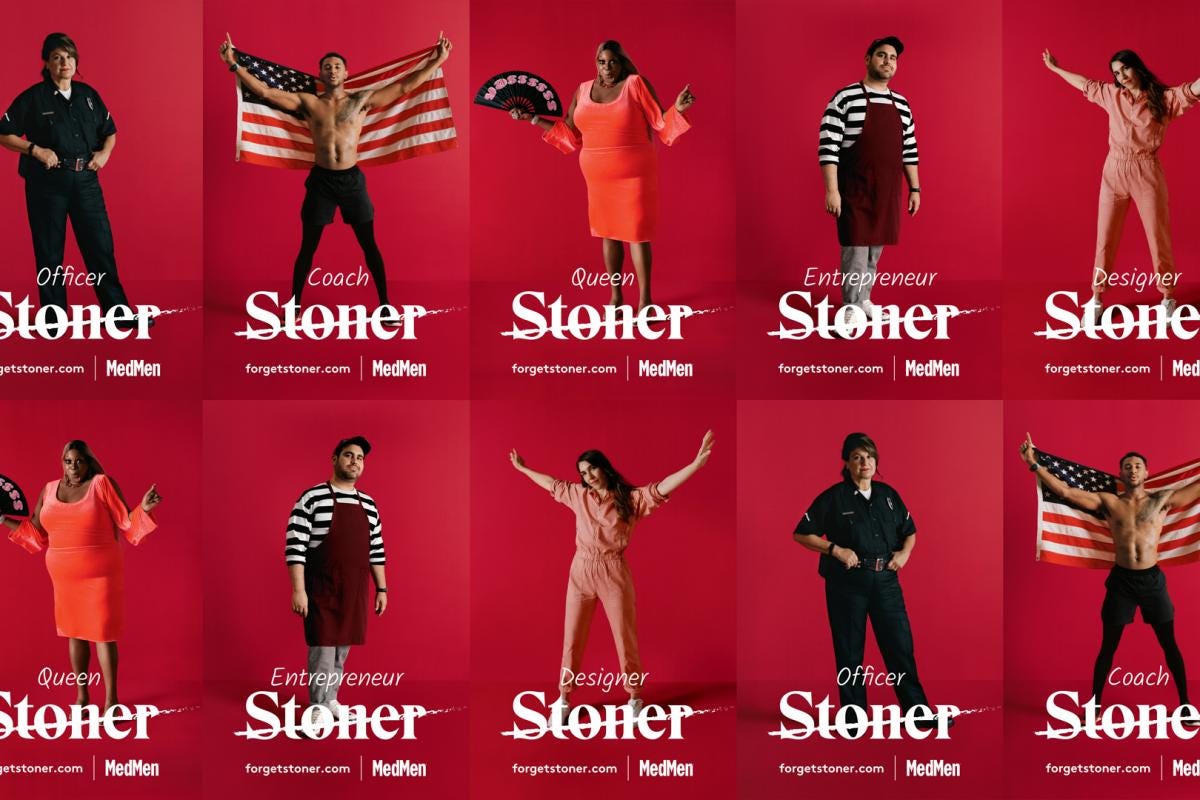


MedMen’s new narrative gave people room to understand that you can be a drug user and still be a good person.
And logic only dictates that if you want to use marijuana, you can still maintain your values and stay a good person, too.
The ads above literally crossed out the old belief and inserted the new one. Now your drug use didn’t define you. Your humanity did.
Changing our values is extremely uncomfortable. Changing our beliefs is a lot easier.
Brands that keep your values in tact but change your subsequent beliefs allow you, the user, to grow without the pain of changing your worldview.
Make sure you separate beliefs from values and know where to insert your narrative.
Yes, you can change values if that’s really where you want to go, but sometimes people only have room to shift their belief systems.
5. Maslow’s hierarchy doesn’t always correlate with wealth.
Somewhere along the line, we started believing wealth pushes people up Maslow’s hierarchy.
But oftentimes it doesn’t.
Not everyone gets to the top of the pyramid. Not even the wealthiest among us.
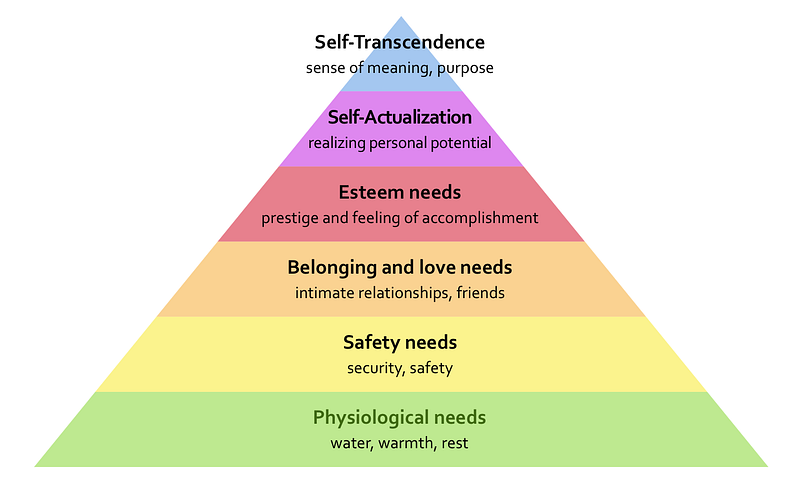
While it may be largely true that increased prosperity moves people up the bottom three tiers, we’ve found in our work that the top two tiers actually correlate a lot less with wealth than you’d expect.
Many consumers in the top 5% have the disposable income to donate to charity, give back to their communities, volunteer, partake in immersive travel, become more spiritual, expand their world views or philosophies (all behaviors that reflect self-actualization and self-transcendence), but get stuck somewhere between the love/ belonging and esteem stages.
Wealth doesn’t move you up the pyramid. Confidence does.
It takes more than money to move up Maslow’s hierarchy.
Mindset, not money, defines where we are.
If you’re surprised that your wealthy neighbors hold xenophobic views, or your prosperous family members won’t give change to homeless people, it’s likely because their money moved up the pyramid faster then their hearts could.
Similarly, just because your customer is affluent doesn’t mean your corporate social responsibility program will resonate or your environmentally friendly practices will keep them from churning.
Make sure you understand where your customer is before you make any assumptions.
If you can help them move up a little faster with your brand, that’s even better.
6. People can have different identities in different parts of their lives.
I call this Poly Identification, and as more and more rules about class, gender and social roles begin to evaporate around us, the more comfortable we have become with letting people carry multiple identities at once.
As I wrote in Business of Fashion last year:
When Chiara Ferragni dresses in head-to-toe Chanel one day and Supreme and sneakers the next, she’s not just mixing styles, she’s moving between spaces.
It’s indicative of a much larger trend of millennial consumers willing to simultaneously identify as preppy, bohemian, emo, street, glam or any other number of subcultures.
Indeed, young consumers increasingly travel between styles instead of committing to a singular diehard identity. Rather than breaking out of the box, they collect boxes that reflect different senses of self at any given moment, on any given day.
It’s obvious in fashion, but also evident in our careers, love lives and social circles.
Kim Kardashian and Howard Stern can travel between wildly different identities without friction. That wouldn’t have been possible a generation ago.
Instead of fitting into boxes, people are increasingly moving between them.
Identities are a mosaic.
You can find a way to let people explore a different dimension of their identities or make a certain dimension fit in with others, but you can’t assume your user looks the same to you as they do in other parts of their lives.
7. You can’t leapfrog fear.
No matter how positive, hopeful or uplifting your brand promise is, you have to resolve any fear that may precede it.
Food tech companies tend to struggle with this.
Impossible Foods, Memphis Meats and Perfect Day have compelling brand messaging, but it all sits on a house of cards. Consumers still have a fear of the unknown in modified foods just as they always have with GMOs.
You can’t skip messages when it comes to fear. Fear must be resolved before any higher message can be adopted.
You already know a confused buyer never buys. Confusion is a form of fear. There are other common forms of fear, too:
- Hate
- Anger
- Misunderstanding
- Phobia
- Bias
A2 Milk is from regular dairy cows while Perfect Day creates dairy without the animal.
Granted, A2 doesn’t have the same battle against consumer biases that Perfect Day has, but they still understand that the fear must be alleviated first before the optimistic horizon can be introduced:
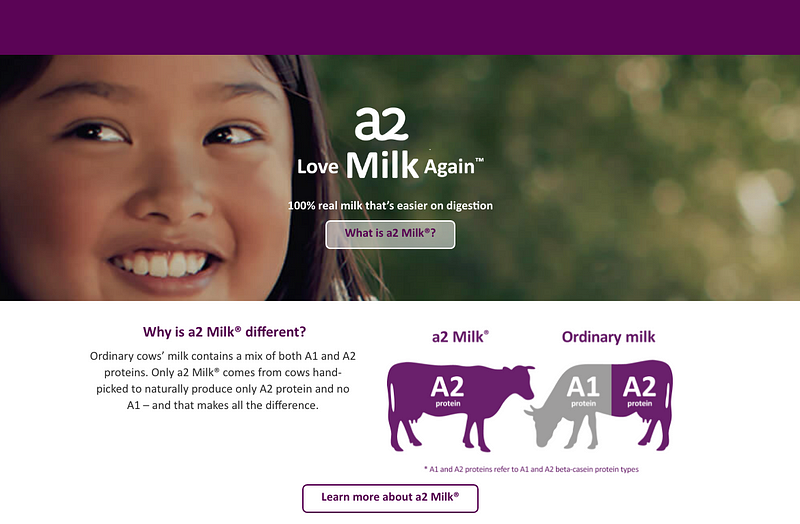
Their messaging turns unspoken fear into a simple story that consumers can tell themselves whenever those uncomfortable feelings crop up.
Perfect Day, on the other hand, let’s an unspoken fear sit in the mind of the consumer:
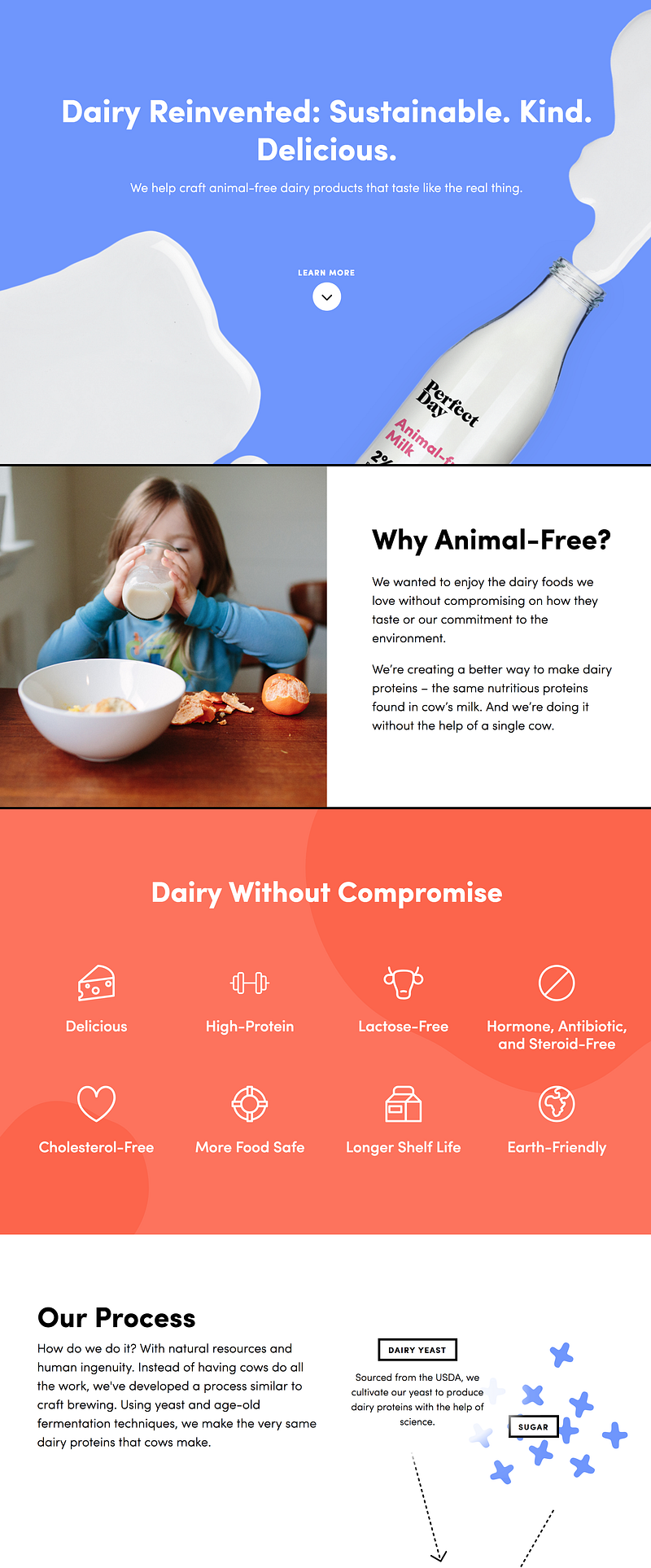
Do a sense check of your brand and see if fear is creeping up anywhere in your user experience. It can be sitting right under a positive sentiment.
Consumers can skip over most other emotions if something bigger is on the horizon, but fear is like quicksand.
Don’t let people get stuck.
8. Everyone has a garden.
Everyone has something they hold dear. Something they nurture often. A place where they focus the expression of their identity.
The mistake we make as brand strategists oftentimes is stopping short of finding that garden.
The garden is that one expressive outlet that reveals far more about your user than any other insight.
You’ll know it when you find it:
- It will be where you user feels the most comfortable to be themselves
- It will reveal what your user values the most
- It will usually tell you when and where you can break the rules
Life hacking is a fascinating garden that reveals a lot about the men and women who spend time in it. Tim Ferris podcasts, Bulletproof Coffee and https://www.reddit.com/r/Nootropics/ all live there.
It’s a garden where men, especially, can obsess freely over their bodies, reveal values that can easily be mistaken for vanity, and give you one important insight that goes against many other commonly held beliefs — that men will pay a lot of money to feel good.
HVMN knows this. That’s why their branding taps directly into a psychographic that wants to “Be Impossible”.
The video’s adrenaline-laced visuals tie in things like aging, mood and cognition, metabolism, obesity, inflammation, Alzheimer’s, Parkinson’s and diabetes.
This is hyper self-care for men.
It’s compulsive wellness. All-consuming self indulgence.
And if you didn’t look in that garden, you may have kept believing the stereotype that men are far less concerned about those things than women.
There is always something valuable in the garden.
If you can find it for your consumers, you’ll hit on something important.
9. We will do a lot to ease our cognitive dissonance.
Cognitive Dissonance occurs whenever we believe something about ourselves, but act in a way that diverges from those beliefs. For example, we may believe we are healthy lovers, but fail to stay in any long term relationships.
That rift between what we believe and what we do creates an unease, and usually points to where we have the most dissatisfaction in our lives.
That’s why the love industry is so big and people are willing to spend immense amounts of money on both legit forms of help (books, therapy) and more questionable ones (reiki practitioners, fortune tellers and energy workers).
Sometimes our entire identities are driven by the motivation to narrow that cognitive gap.
Esther Perel understands that as desperately as we want to see ourselves as enlightened romantic partners, we do very little to actually get there. That’s why she’s positioned herself as a relationship explorer.
Instead of offering relationship advice in the traditional form that only creates more distance between who we are and how we see ourselves, she offers a path for self-discovery.
The Esther Perel experience allows people to see themselves as experts instead of disciples, and that brings our behavior a lot closer to our beliefs. She teaches us not how to fix, but how to think.
Look for gaps that need closing in the minds of your own audience.
Solving a problem for your user is great, but easing their cognitive dissonance can have a much greater emotional impact.
There is likely something that your user wants more than just a solution.
[More on that here: The Cognitive Dissonance Hiding Behind Strong Brands.]
10. “Everyone is a hero in their own story” … but there are different kinds of heroes.
If you’ve read my writing, you know this is one of my favorite quotes.
It forces you to identify with anyone, and without judgement. I often refer to this quote when I find myself bothered or turned off by a customer profile because it brings me back to a place of empathy right away and helps me see the goal my user sees.
Empathy is a great homing device.
Keep in mind, however, that different people are different kinds of heroes:
- There are the anti-heroes that look like villains on the outside and need someone to see them for who they truly are
- There are the reluctant heroes that not only need the motivation to take on their destinies, but are secretly hoping and waiting for someone to give it to them
- There are the catalyst heroes who act heroically, but rarely want change much themselves in the process
- There are the tragic heroes that believe they will continue to stumble and fail, and may resist a narrative that says otherwise
- There are the willing heroes who are eager to take on the challenge, and expect to get the Hollywood ending
Every kind of hero needs a different kind of message, but every one of them can be motivated to act.
Understand your hero, and you will understand how to make them move.
An anti-hero (like Harley Davidson’s customer) needs to be discovered while a willing hero (like Nike’s customer) expects you to already know who he is.
11. The journey is starting to matter more than the destination.
Something has started to change in the psyche of most post-boomer American consumers.
The end goal is starting to matter less, and the experience of getting there is starting to matter more.
Consumers are gradually entering a constant state of evolution.
Rather than defining themselves as who they are (a state of being), they are defining themselves by who they are turning into (a state of becoming).
Our ever-evolving co-working setups, our daily experiments in beauty and nutrition, and the transformative experiences we fervently search for in everything we do (from spiritually uplifting SoulCycle sessions to healing travel) show how the becoming piece matters more and more.
I refer to this as the treadmill vs. the step ladder. Previous generations understood social class and the incremental step ladder you moved up into in each rung.
Today we are moving along something that looks far more like a treadmill — no destination and no gatekeepers, but a constant experience of moving upward.
When people move from a ladder to a treadmill, you need to center your brand around the journey, not the end point.
That’s an important difference.
[More on this here: In The Transformational Economy, ‘Being’ and ‘Becoming’ Have Started To Merge.]
12. There are utility users, and there are premium users. You can’t speak to both, but you can turn one into the other.
Every client we work with wants to move upmarket to a more premium user, but many of them get scared when they realize that premium positioning will likely box out their core utility user base… even when that core is limiting them.
You can’t win over both with the same branding, but you can turn a utility user into a premium one.
Utility users need to be educated into caring about the right things. You need to find something more important than value-for-price that they can latch onto.
Lululemon didn’t miss out on a mainstream market. They turned a mainstream market into a premium one by educating and transforming those users into discerning yoga wear addicts.
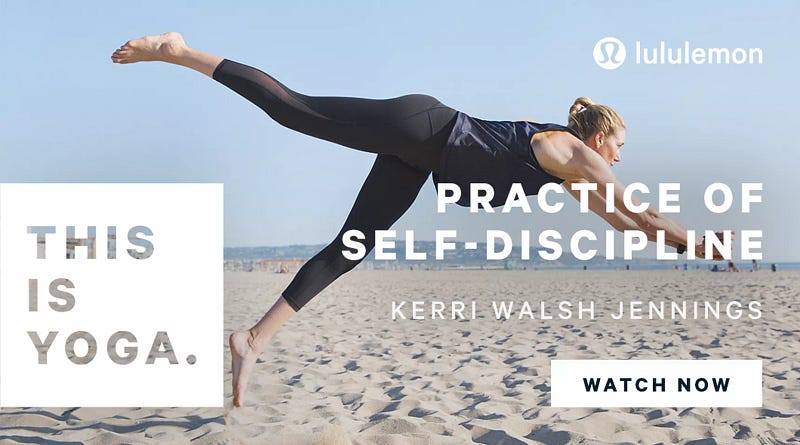
If you feel yourself sweating in the brand strategy process because you don’t want to leave your non-premium core behind, change your perspective.
You don’t have to leave them behind. You have to change them so they’ll come with you.
Give them a message that will make price irrelevant.
13. There is value in the ‘in-between’ spaces.
Consumers in every vertical of every category are looking for greater meaning, and they’re finding it in the connections between spaces.
Health is no longer just a doctor’s visit. It’s mind-body-spirit. It’s a juice cleanse, a heart-to-heart with your partner and a colonic. It’s a trainer and a nutritionist and therapist.
Beauty is no longer just an eye cream. It’s a non-inflammatory diet, a 24 karat facial and stem cell serums.
Career success is no longer a well paying office job. It’s a personal brand, an active blog and a creative side gig.
The connections between spaces have put new life into old paradigms.
Connections give consumers the answers (and narratives) they’re looking for.
All of these examples create a narrative of how and why we do things.
They add meaning and value in a way we can control. Instead of just trusting a drugstore eye cream brand, you have an empowering story of how and why your beauty routine is working.
Just like religion and folklore, connective stories become part of our hardwiring.
Look for how your brand can connect to more than just one part of someone’s life. There is a story to be told that is much bigger than your product.
Make the connection and go deeper into your consumer’s world.
14. Identity is a story.
Truth has very little to do with identity. How we interpret that truth is what matters.
To change a person is to change the stories that define them.
Every construct on this list culminates in this one, simple fact.
If you want to really see a person, look beyond the ‘truth’ of their external lives — listen to the stories they tell themselves internally.
Behavior, belief, bias, conversion all weave together to tell a tale. No one of these things can demonstrate who your consumer is. But together, they do just that.
Don’t get distracted by facts and statistics. Don’t chase after trends.
Instead listen for the story arc that emerges from them.
(Here are some common ones we all like to tell ourselves: Pain, Villains and Fuck You Money)
Reaching For Identity
Searching for identity can feel like grabbing at clouds. Just when you think you’re holding the truth, it slips through your fingers.
That’s because truly understanding someone else’s identity is an out-of-body kind of experience. It’s one thing to see it on paper. It’s another thing to feel it your bones.
“The shortest distance between two people is a story.”
― Patti Digh
But no matter how you cut it, identity is where it all starts.
You can’t know where your brand belongs if you don’t know what world it’s living in.
This is a companion piece to The 16 Rules of Brand Strategy.




